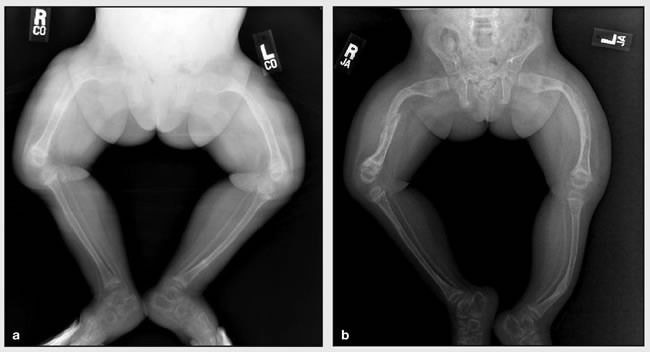Osteogenesis Imperfecta
Genetic_DisordersOriginal Editors - Barrett Mattingly from Bellarmine University's Pathophysiology of Complex Patient Problems project.
Top Contributors - Barrett Mattingly, Lucinda hampton, Jess Bell, Admin, Uchechukwu Chukwuemeka, Kim Jackson, Robin Tacchetti, Kirenga Bamurange Liliane, Dave Pariser, WikiSysop, Wendy Walker, Meaghan Rieke, Anna Fuhrmann, 127.0.0.1, Heidi Johnson Eigsti and Elaine Lonnemann
Introduction[edit | edit source]
Osteogenesis imperfecta (OI) refers to a heterogeneous group of congenital, non-sex-linked, genetic disorders of collagen type I production, involving connective tissues and bones.
The hallmark feature of osteogenesis imperfecta is osteoporosis and fragile bones that fracture easily, as well as, blue sclera, dental fragility and hearing loss. There is extreme variation in clinical symptoms based on genetic basis and subtypes[1].
The primary manifestations are fractures, bone deformity, and bone pain, resulting in reduced mobility and function to complete everyday tasks. OI affects not only the physical but also the social and emotional well-being of children, young people, and their families. The multidisciplinary approach to the treatment of children and young people living with OI seeks to provide well-coordinated, comprehensive assessments, and interventions that place the child and family at the very center of their care. The coordinated efforts of a multidisciplinary team can support children with OI to fulfill their potential, maximizing function, independence, and well-being.[2]
Types of OI[edit | edit source]
Three main types are easily distinguished
Type I. Mildest and most common type. About 50% of all affected children have this type. There are few fractures and deformities
Type II. Most severe type. A baby has very short arms and legs, a small chest, and soft skull. He or she may be born with fractured bones. He or she may also have a low birth weight and lungs that are not well developed. A baby with type II OI usually dies within weeks of birth
Type III. Most severe type in babies who don’t die as newborns. At birth, a baby may have slightly shorter arms and legs than normal and arm, leg, and rib fractures. A baby may also have a larger than normal head, a triangle-shaped face, a deformed chest and spine, and breathing and swallowing problems. These symptoms are different in each baby[3].
Types IV to VIII are variable in severity and uncommon[1]
Epidemiology[edit | edit source]
The estimated incidence is approximately 1 in every 12,000-15,000 births 2. Osteogenesis imperfecta occurs with equal frequency among males and females and across races and ethnic groups. The lifespan varies with the type. [1]
Etiology[edit | edit source]
Osteogenesis imperfecta is a rare genetic disease. In the majority of cases, it occurs secondary to mutations in the COL1A1 and COL1A2 genes. More recently, there has been the identification of diverse mutations related to OI.[4]
Below is a documentary from the Discovery Channel titled "Children of Glass" courtesy of Youtube.com.
Characteristics/Clinical Presentation[edit | edit source]
Type III[edit | edit source]
Diagno[edit | edit source]
- Yochum TR, Kulbaba S, Seibert RE. Osteogenesis Imperfecta in a Weightlifter. Journal of Manipulative and Physiological Therapeutics; 25: 334-339. 2002.
- Strevel EL, Adachi JD, Papaioannou A, McNamara M. Case Report: Osteogenesis Imperfecta Elusive Cause of Fractures. Canadian Family Physician; 51: 1655-1657.2005.
- Iwamoto J, Takeda T, Sato Y. Effect of Treatment With Alendronate in Osteogenesis Imperfecta Type I: A Case Report. The Keio Journal of Medicine; 53 (4): 251–255. 2004.
- Aoki T, Kuraoka S, Ohtani S, Kuroda Y. Aortic Valve Replacement in a Woman with Osteogenesis Imperfecta. Annals of Thoracic and Cardiovascular Surgery; 8(1): 51-53. 2002.
Resources[edit | edit source]
- http://www.oif.org
- http://www.genome.gov/25521839
- http://www.osteogenesisimperfecta.org
- http://www.nlm.nih.gov/medlineplus/osteogenesisimperfecta.html
- http://ghr.nlm.nih.gov/condition=osteogenesisimperfecta
- http://www.brittlebone.org
References[edit | edit source]
- ↑ 1.0 1.1 1.2 Radiopedia Osteogenesisi Imperfecta Available: https://radiopaedia.org/articles/osteogenesis-imperfecta-1(accessed 15.10.2021)
- ↑ Marr C, Seasman A, Bishop N. Managing the patient with osteogenesis imperfecta: a multidisciplinary approach. Journal of multidisciplinary healthcare. 2017;10:145.Available: https://www.ncbi.nlm.nih.gov/pmc/articles/PMC5388361/ (accessed 15.10.2021)
- ↑ John Hopkins OI Available: https://www.hopkinsmedicine.org/health/conditions-and-diseases/osteogenesis-imperfecta (accessed 15.10.2021)
- ↑ Subramanian S. StatPearls Publishing LLC.; Treasure Island, FL, USA: 2021. Osteogenesis Imperfecta.Available:https://www.ncbi.nlm.nih.gov/books/NBK536957/ (accessed 15.10.2021)
- ↑ Bublitz Videos. Children of Glass - (Part 1 of 4). Available from: http://www.youtube.com/watch?v=TpAMTOud3bw [last accessed 27/8/2020]
- ↑ Bublitz Videos. Children of Glass - (Part 2 of 4). Available from: http://www.youtube.com/watch?v=GTpSxlPzC8k [last accessed 37/8/2020]
- ↑ Bublitz Videos. Children of Glass - (Part 3 of 4). Available from: http://www.youtube.com/watch?v=L2f8fz6vzoI [last accessed 27/8/2020]
- ↑ Bublitz Videos. Children of Glass - (Part 4 of 4). Available from: http://www.youtube.com/watch?v=QvbY7XqyMz8 [last accessed 27/8/2020]







